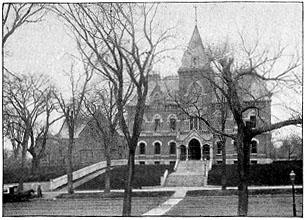 Left: Springfield Public Library Left: Springfield Public Library
magazines. The builders provided for the storage of 80,000 volumes, which seemed to them enough for future growth. But only twenty years have elapsed, and the limit has been reached. The beautiful and commodious building being an accomplished fact, the Association bent
its energies to securing larger appropriations, with such success that in 1892 it received from the city $18,498.38. The library has been brought into close connection with the public schools. Teachers' cards permit teachers to take out a considerable number of books at a time for professional and class use; and generally a visit to any schoolroom of higher grade will reveal the presence of library books that are being used in connection with school work. Classes from the high and grammar schools frequently visit the library in company with their teachers, to study particular subjects. This close connection between the City Library and the schools has the additional value of making the pupils familiar with the institution and the books in it, and the influence for good of this upon the young minds is very great. Lists of books especially adapted to school use have been printed and placed in the hands of teachers.
It is impossible to consider the service of the City Library to the schools, and to the citizens in general, without noting the master hand behind it. Without untiring effort and rare judgment, the librarian could never have brought the institution to such a position in the community. For thirty-two years, Rev. William Rice has made this library his study. It has been his constant aim to make such a collection of books that minds of divergent needs might always find information on any topic, and to so arrange the books and regulate their use that they might do the greatest good to the greatest number.
It was part of Dr. Rice's plan that an Art Museum should be erected by the Association on grounds adjoining the library building.
The room devoted to the museum in the library has long been needed for library purposes. At the annual meeting of the Association in 1889, a letter was read from G. W. V. Smith, proposing to bequeath his valuable collection of paintings, drawings, antique furniture, bronzes, porcelains and ceramics, arms and armor, wood and ivory carvings, and
bric-a-brac of various nature, for the perpetual use of the city of Springfield, upon the condition that they should be provided for in a suitable building in separate rooms from the works donated by others. Mr. Smith proposed to leave a considerable sum of money, the income from which should be used to make additions to the collection. This Art
Building has now become a reality, the structure itself being a thing of beauty.
There are thirty-seven church organizations in Springfield, — thirteen Congregational, six Methodist, six Baptist, five Roman Catholic, two Protestant Episcopal, two Lutheran, and one each Unitarian, Universalist, and Swedenborgian. Some of the church edifices are conspicuous among the architectural ornaments of the city, the South Congregational and Unitarian Churches being especially worthy of notice. The First Church dates its beginning from the settlement of the town in 1636, being the fourteenth church organized in the colony of Massachusetts Bay. Not till 1645 was a meet-
-- Page 20 --
© Laurel O'Donnell 1998 - 2005, all rights reserved
This document may be downloaded for personal non-commerical use only
and should not be reproduced or distributed without permission.
|
 Left: Springfield Public Library
Left: Springfield Public Library